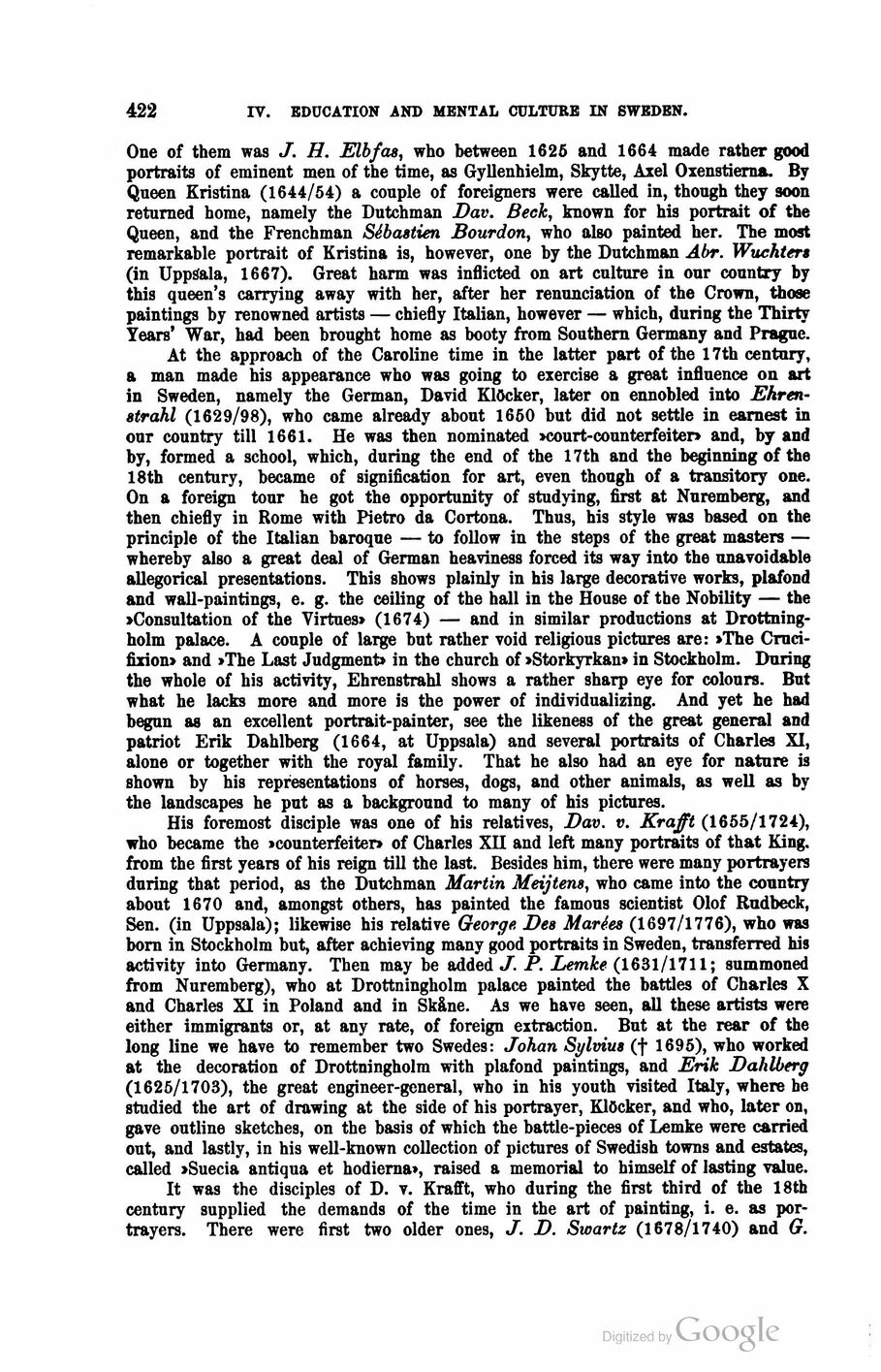
Full resolution (JPEG) - On this page / på denna sida - First part - IV. Education and Mental Culture - 9. The Fine Arts - Painting, by Prof. C. R. Nyblom, Ph. D., Stockholm

<< prev. page << föreg. sida << >> nästa sida >> next page >>
Below is the raw OCR text
from the above scanned image.
Do you see an error? Proofread the page now!
Här nedan syns maskintolkade texten från faksimilbilden ovan.
Ser du något fel? Korrekturläs sidan nu!
This page has never been proofread. / Denna sida har aldrig korrekturlästs.
422
IV. EDUCATION AND MENTAL CULTURE IN SWEDEN.
One of them was J. H. Elbfas, who between 1625 and 1664 made rather good
portraits of eminent men of the time, as Gyllenhielm, Skytte, Axel Oxenstierna. By
Qneen Kristina (1644/54) a couple of foreigners were called in, though they soon
returned home, namely the Dutchman Dav. Beck, known for his portrait of the
Queen, and the Frenchman Sébastien Bourdon, who also painted her. The most
remarkable portrait of Kristina is, however, one by the Dutchman Abr. Wuchters
(in Uppsala, 1667). Great harm was inflicted on art culture in our country by
this queen’s carrying away with her, after her renunciation of the Crown, those
paintings by renowned artists — chiefly Italian, however — which, during the Thirty
Years’ War, had been brought home as booty from Southern Germany and Prague.
At the approach of the Caroline time in the latter part of the 17th century,
a man made his appearance who was going to exercise a great influence on art
in Sweden, namely the German, David Klöcker, later on ennobled into
Ehrenstrahl (1629/98), who came already about 1650 but did not settle in earnest in
our country till 1661. He was then nominated »court-counterfeiter» and, by and
by, formed a school, which, during the end of the 17th and the beginning of the
18th century, became of signification for art, even though of a transitory one.
On a foreign tour he got the opportunity of studying, first at Nuremberg, and
then chiefly in Rome with Pietro da Cortona. Thus, his style was based on the
principle of the Italian baroque — to follow in the steps of the great masters —
whereby also a great deal of German heaviness forced its way into the unavoidable
allegorical presentations. This shows plainly in his large decorative works, plafond
and wall-paintings, e. g. the ceiling of the hall in the House of the Nobility — the
»Consultation of the Virtues» (1674) — and in similar productions at
Drottningholm palace. A couple of large but rather void religious pictures are: »The
Crucifixion» and »The Last Judgment» in the church of »Storkyrkan» in Stockholm. Dnring
the whole of his activity, Ehrenstrahl shows a rather sharp eye for colours. But
what he lacks more and more is the power of individualizing. And yet he had
begun as an excellent portrait-painter, see the likeness of the great general and
patriot Erik Dahlberg (1664, at Uppsala) and several portraits of Charles XI,
alone or together with the royal family. That he also had an eye for nature is
shown by his representations of horses, dogs, and other animals, as well as by
the landscapes he put as a background to many of his pictures.
His foremost disciple was one of his relatives, Dav. v. Krafft (1655/1724),
who became the »counterfeiter» of Charles XH and left many portraits of that King,
from the first years of his reign till the last. Besides him, there were many portrayers
during that period, as the Dutchman Martin Meijtens, who came into the country
about 1670 and, amongst others, has painted the famous scientist Olof Rudbeck,
Sen. (in Uppsala); likewise his relative George. Des Marées (1697/1776), who was
born in Stockholm but, after achieving many good portraits in Sweden, transferred his
activity into Germany. Then may be added J. P. Lemke (1631/1711; summoned
from Nuremberg), who at Drottningholm palace painted the battles of Charles X
and Charles XI in Poland and in Skåne. As we have seen, all these artists were
either immigrants or, at any rate, of foreign extraction. But at the rear of the
long line we have to remember two Swedes: Johan Sylvius († 1695), who worked
at the decoration of Drottningholm with plafond paintings, and Erik Dahlberg
(1625/1703), the great engineer-general, who in his youth visited Italy, where he
studied the art of drawing at the side of his portrayer, Klöcker, and who, later on,
gave outline sketches, on the basis of which the battle-pieces of Lemke were carried
out, and lastly, in his well-known collection of pictures of Swedish towns and estates,
called »Suecia antiqua et hodierna», raised a memorial to himself of lasting value.
It was the disciples of D. v. Krafft, who during the first third of the 18th
century supplied the demands of the time in the art of painting, i. e. as
portrayers. There were first two older ones, J. D. Swartz (1678/1740) and G.
<< prev. page << föreg. sida << >> nästa sida >> next page >>